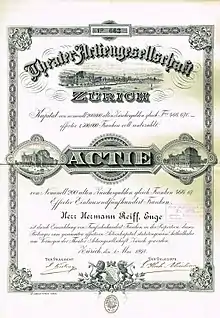.jpg.webp) Opernhaus Zürich in 2019 | |
| Address | Sechseläutenplatz 1 Zürich Switzerland |
|---|---|
| Type | Opera house |
| Website | |
| www.opernhaus.ch | |
The Zürich Opera House (German: Opernhaus Zürich) is an opera house in the Swiss city of Zürich. Located at the Sechseläutenplatz, it has been the home of the Zürich Opera since 1891, and also houses the Bernhard-Theater Zürich. It is also home to the Zürich Ballet.
It received the "Opera Company of the Year" award at the 2014 International Opera Awards.[1]
History
The first permanent theatre in Zürich, the Aktientheater, was built in 1834 and it became the focus of Richard Wagner’s activities during his period of exile from Germany.
The Aktientheater burnt down in 1890. The new Stadttheater Zürich (municipal theatre) was built by the Viennese architects Fellner & Helmer, who changed their previous design for the theatre in Wiesbaden only slightly.

It was built in only 16 months and was opened in 1891[2] and became the first opera house in Europe to have electrical lighting.[3]

It was the city's main performance space for drama, opera, and musical events until 1925, when the Bernhard Theater was built for separate plays. Opening in 1941, the Esplanada building was demolished in May 1981, and the present adjoint building opened on 27/28 December 1984 after three years of transition in the Kaufhaus building nearby Schanzengraben.The original theatre was renamed to the Zürich Opera House in 1964.[5]
By the 1970s, the opera house was badly in need of major renovations; when some considered it not worth restoring, a new theatre was proposed for the site. However, between 1982 and 1984, rebuilding took place but not without huge local opposition which was expressed in street riots. The rebuilt theatre was inaugurated with Wagner’s Die Meistersinger von Nürnberg and the world première of Rudolf Kelterborn’s Chekhov opera Der Kirschgarten.
As restored, the theatre is an ornate building with a neo-classical façade of white and grey stone adorned with busts of Weber, Wagner, and Mozart. Additionally, busts of Schiller, Shakespeare, and Goethe are to be found. The auditorium is built in the neo-rococo style and seats approximately 1200 people. During the refurbishment, the issue of sightlines was not adequately addressed. As a result, the theatre has a high number of seats with a limited view, or no view, of the stage. This is unusual in international comparison, where sightlines in historic opera houses have been typically enhanced over time.
Corporate archives and historical library collections are held at the music department of the Predigerkirche Zürich.[6]
The Opera House also holds concerts by its Philharmonia orchestra, matinees, Lieder evenings and events for children.[3]
Opera Studio
The Zürich Opera House is also home of the International Opera Studio (in German: Internationales Opernstudio IOS) which is a educational program for young singers and pianists. The studio was created in 1961[7] and has renowned artists currently teaching such as Brigitte Fassbaender, Hedwig Fassbender, Andreas Homoki, Adrian Kelly, Ann Murray, Eytan Pessen, Fabio Luisi or Edith Wiens.
Youth protests of 1980
In response to the combination of high subsidies for the Opera and the lack of cultural programs for the youth in Zürich, large protests were held in May 1980. The protests became known as the Opernhauskrawalle youth protests – Züri brännt,[8] meaning Zurich is burning, as documented in the 1981 Swiss documentary film of the same name.
Financing
Opernhaus Zürich AG is organised pursuant to Swiss law as a company limited by shares and it operates a music theater and Ballet under the authority of Canton of Zurich that has been providing the main funding since 1995.[3] Both Swiss banks, UBS and Credit Suisse, as well as Rolex are partners of Opernhaus Zürich AG.[9]
References
- ↑ "Winners 2014". International Opera Awards. Retrieved 9 October 2023.
- ↑ "Tonhalle" (in German). planet-zurich.com. 2010. Archived from the original on 26 April 2012. Retrieved 5 December 2011.
- 1 2 3 "Global Recognition. Zurich sidesteps the opera 'crisis'". SWI swissinfo.ch, a branch of the Swiss Broadcasting Corporation. 25 July 2014. Retrieved 25 July 2019.
- ↑ Anniversary publication of the Theater-Aktiengesellschaft from 2009 (in german)
- ↑ www.update.ch, update AG. "History". www.opernhaus.ch. Retrieved 2023-07-14.
- ↑ "Musikabteilung" (in German). Zentralbibliothek Zürich. Retrieved 2014-12-25.
- ↑ www.update.ch, update AG. "Internationales Opernstudio". www.opernhaus.ch (in German). Retrieved 2019-12-26.
- ↑ "10vor10 - TV - SRF Player" (in German). 10vor10. 2015-01-16. Retrieved 2015-01-16.
- ↑ https://www.opernhaus.ch/
External links
- Zürich Opera’s official website
- Marco Badilatti (2005). "Opernhaus Zürich, Zürich ZH". In Andreas Kotte (ed.). Theaterlexikon der Schweiz / Dictionnaire du théâtre en Suisse / Dizionario Teatrale Svizzero / Lexicon da teater svizzer [Theater Dictionary of Switzerland] (in German). Vol. 2. Zürich: Chronos. pp. 1350–1352. ISBN 978-3-0340-0715-3. LCCN 2007423414. OCLC 62309181.